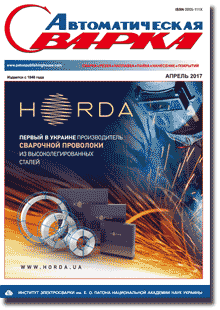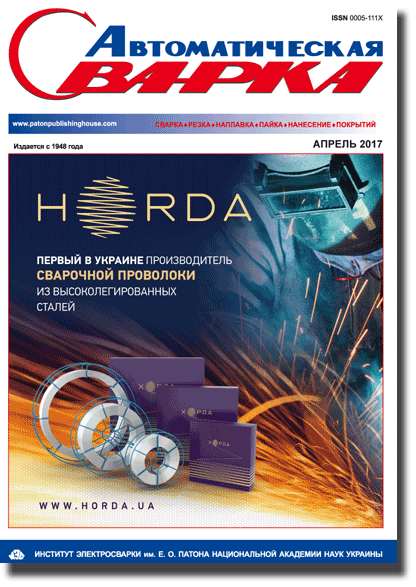| 2017 №04 (03) |
DOI of Article 10.15407/as2017.04.04 |
2017 №04 (05) |

Avtomaticheskaya Svarka (Automatic Welding), #4, 2017, pp. 21-24
Physico-mechanical properties of thin-sheet aluminum alloy D16 butt joints produced by friction stir welding
A.G. Poklyatsky, S.I. Motrunich and I.N. Klochkov
E.O. Paton Electric Welding Institute, NASU 11 Kazimir Malevich Str., 03680, Kiev, Ukraine. E-mail: office@paton.kiev.ua
Abstract
A complex of investigations was carried out to study the strength characteristics of welded butt joints of structural aluminum alloy D16 of 2 mm thickness, produced by friction stir welding. It was shown that the use of friction stir welding provides the formation of a permanent joint with a minimum level of stress concentration in the transition zones from the weld to the base material and allows avoiding the formation of defects in the welds such as pores, macroinclusions of oxide film and hot cracks caused by melting and crystallization of metal in fusion welding. As a result of intensive plastic deformation in the weld metal, a homogeneous disoriented structure with a grain size of 3–4 ?m and with dispersed phase precipitations of not more than 1 ?m is formed, and in the regions adjacent to it the elongation and distortion of grains in the direction of movement of the plasticized metal occurs in the zone of thermomechanical action. Due to this, the hardness of metal in the joint zone, the tensile strength under uniaxial tension and the fatigue strength under cyclic loads are increased. 11 Ref., 6 Figures.
Keywords: friction stir welding, aluminum alloy D16, hardness, tensile strength, fatigue resistance
Received: 20.02.17
Published: 17.04.17
References
- Fridlyander, I.N. (2002) Aluminium alloys in aircrafts during 1970–2000 and 2001–2015. Tekhnologiya Lyogkikh Splavov, 4, 12–17.
- Shvechkov, E.I., Zakharov, V.V., Rostova, T.D. (2003) To problem on selection of aluminium alloy grade for cover plates. Ibid., 1, 17–21.
- Beletsky, V.M., Krivov, G.A. (2005) Aluminium alloys (composition, properties, technology, application). Ed. by I.N. Fridlyander. Kiev: KOMINTEKh.
- Friction stir butt welding. Int. pat. application PCT/GB 92/02203. GB pat. appl. 9125978.8. Publ. 1991.
- Pietras, A., Zadroga, L. (2003) Rozwoj metody zdrzewania tarciowego z mieszaniem materialu zgrzeiny (FSW) i mozliwosci jej zastosowania. Instytutu Spawalnictwa, 5, 148–154.
- Defalco, J. (2006) Friction stir welding vs fusion welding. Welding J., 3, 42–44.
- Enomoto, M. (2003) Friction stir welding: research and industrial applications. Welding International, 5, 341–345. https://doi.org/10.1533/wint.2003.3114
- Sato, Y. (2002) Relationship between mechanical properties and microstructure in friction stir welded Al alloys. JJWS, 8, 33–36. https://doi.org/10.2207/qjjws1943.71.581
- Shibayanagi, T. (2007) Microstructural aspects in friction stir welding. of Japan Inst. of Light Metals, 9, 416–423. https://doi.org/10.2464/jilm.57.416
- Tool for friction stir welding of aluminium alloys. Pat. 54096 Ukraine. Int. Cl. K B23K 20/12. 30.04.2010. Publ. 25.10.2010.
- Poklyatsky, A.G. (2001) Peculiarities of formation of macroinclusions of oxide film in weld metal of aluminium alloys (Review). The Paton Welding J., 3, 36–38.
The cost of subscription/purchase order journals or individual articles
| Journal/Currency | Annual Set | 1 issue printed |
1 issue |
one article |
| TPWJ/USD | 384 $ | 32 $ | 26 $ | 13 $ |
| TPWJ/EUR | 348 € | 29 € | 24 € | 12 € |
| TPWJ/UAH | 7200 UAH | 600 UAH | 600 UAH | 280 UAH |
| AS/UAH | 1800 UAH | 300 UAH | 300 UAH | 150 UAH |
| AS/USD | 192 $ | 32 $ | 26 $ | 13 $ |
| AS/EUR | 180 € | 30 € | 25 € | 12 € |
| SEM/UAH | 1200 UAH | 300 UAH | 300 UAH | 150 UAH |
| SEM/USD | 128 $ | 32 $ | 26 $ | 13 $ |
| SEM/EUR | 120 € | 30 € | 25 € | 12 € |
| TDNK/UAH | 1200 UAH | 300 UAH | 300 UAH | 150 UAH |
| TDNK/USD | 128 $ | 32 $ | 26 $ | 13 $ |
| TDNK/EUR | 120 € | 30 € | 25 € | 15 € |
AS = «Automatic Welding» - 6 issues per year;
TPWJ = «PATON WELDING JOURNAL» - 12 issues per year;
SEM = «Electrometallurgy Today» - 4 issues per year;
TDNK = «Technical Diagnostics and Non-Destructive Testing» - 4 issues per year.





